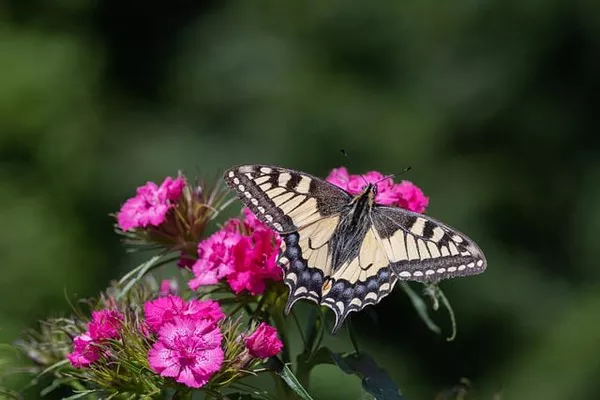Butterflies, those delicate and colorful creatures that gracefully flutter through gardens, add a touch of enchantment to any outdoor space. If you’re keen to create a haven for these delightful insects, it’s crucial to know which flowers will entice them. In this comprehensive guide, we’ll explore the world of butterfly-friendly flowers, shedding light on the types, colors, and nectar-rich blooms that will make your garden a butterfly paradise.
Why Attract Butterflies?
Before delving into the flowers that beckon butterflies, it’s important to understand why these charming insects are worth your gardening efforts. Butterflies, beyond their aesthetic appeal, play a vital role in pollination. They transfer pollen from one flower to another, aiding in the reproduction of plants. A garden that welcomes butterflies is not only beautiful but also contributes to biodiversity and the overall health of your ecosystem.
Types of Flowers That Attract Butterflies
Butterflies are discerning when it comes to nectar sources. They seek flowers with specific characteristics that make feeding easier and more efficient. Here are some flower types that are known to be particularly attractive to butterflies:
Coneflowers (Echinacea): With their vivid hues and daisy-like appearance, coneflowers are a favorite among butterflies, including the striking Monarchs. These resilient perennials offer an abundant nectar source.
Lantanas: Lantanas come in various shades, from vibrant oranges to sunny yellows, making them a magnet for a range of butterfly species. These hardy, heat-tolerant plants are a staple in butterfly gardens.
Zinnias: Zinnias are a staple in many butterfly gardens due to their brightly colored, dahlia-like blooms. Their nectar-rich flowers provide ample sustenance for visiting butterflies.
Butterfly Bush (Buddleia): As the name suggests, this shrub is a true butterfly magnet. Its elongated clusters of tiny flowers offer a prolific source of nectar, attracting various butterfly species.
Asters: Asters bloom late in the season, providing a crucial food source for butterflies as they prepare for migration. These daisy-like flowers are particularly attractive to Painted Ladies and American Ladies.
Milkweed: No discussion of butterfly-friendly plants is complete without mentioning milkweed. It is the sole host plant for Monarch butterflies, serving as a nursery for their caterpillars. Planting milkweed is a crucial step in supporting Monarch populations.
Colors That Captivate Butterflies
While butterflies may seem whimsical, they exhibit preferences for certain flower colors. Understanding these preferences can help you plan a garden that is even more appealing to these winged wonders:
Red: Butterflies like the Red Admiral are drawn to bright red flowers. Consider planting Red Hot Pokers (Kniphofia) or Red Salvia to attract them.
Yellow: Yellow is a universally loved color among butterflies. Plants like Coreopsis and Black-Eyed Susans (Rudbeckia) are adorned with yellow petals that beckon these insects.
Orange: Monarchs and Fritillaries adore orange blooms. Marigolds and Butterfly Weed (Asclepias tuberosa) are great choices to provide these vivid hues.
Pink: Pink is another favorite among butterflies, especially the Painted Lady. Try planting Pink Coneflowers (Echinacea) or Bee Balm (Monarda) for these charming visitors.
Purple: The delicate Great Spangled Fritillary is often seen hovering around purple flowers. Consider adding Purple Coneflowers or Lavender to your garden palette.
Blue: While less common, some species, like the Eastern Tailed-Blue, are attracted to blue flowers. Try planting Blue Salvia or Lobelia to capture their attention.
Planting for Continuous Blooms
Creating a butterfly-friendly garden is not just about the types and colors of flowers but also about planning for continuous blooms. Butterflies are active from spring to fall, so it’s essential to have a variety of flowers that bloom at different times throughout the season. Here’s how to achieve this:
Early Bloomers: Spring-blooming flowers like Primroses and Hellebores provide essential nectar for emerging butterflies.
Mid-Season Stars: Flowers like Irises, Phlox, and Roses offer sustenance during the peak of butterfly activity in summer.
Late Bloomers: To support butterflies preparing for migration, choose late-season flowers such as Sedums and Asters.
Perennials and Annuals: Incorporating both perennial and annual plants ensures a consistent supply of nectar throughout the year.
Native Plants: Consider adding native plants to your garden, as they are well-suited to local butterfly species.
Additional Tips for Butterfly Gardens
Avoid Pesticides: Butterflies are highly sensitive to pesticides. Opt for organic pest control methods to protect your garden’s delicate visitors.
Provide Sun and Shelter: Most butterflies prefer sunny spots with protection from strong winds. Ensure your garden offers a mix of open and sheltered areas.
Include Host Plants: Besides nectar plants, consider incorporating host plants where butterflies can lay their eggs. For instance, if you want Monarchs, plant milkweed.
Avoid Invasive Species: Some non-native plants can outcompete native species and harm local ecosystems. Research local flora to ensure you’re planting responsibly.
In conclusion
attracting butterflies to your garden is a delightful endeavor that promotes biodiversity and adds a touch of magic to your outdoor space. By selecting the right flowers, colors, and a variety of blooms, you can create a haven that not only appeals to butterflies but also enhances your gardening experience. With a little planning and care, your garden can become a sanctuary where both you and these exquisite creatures can flourish side by side.


